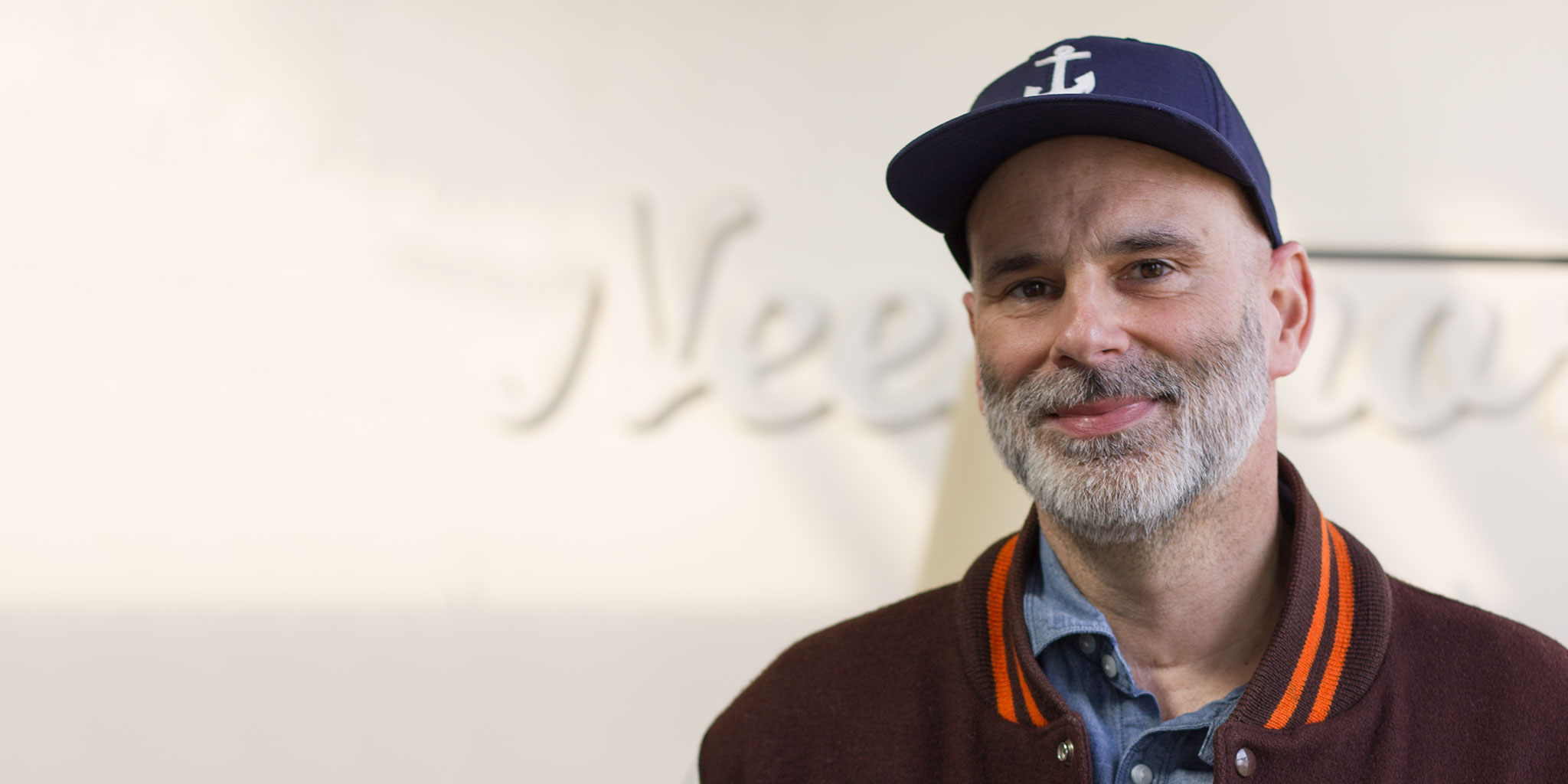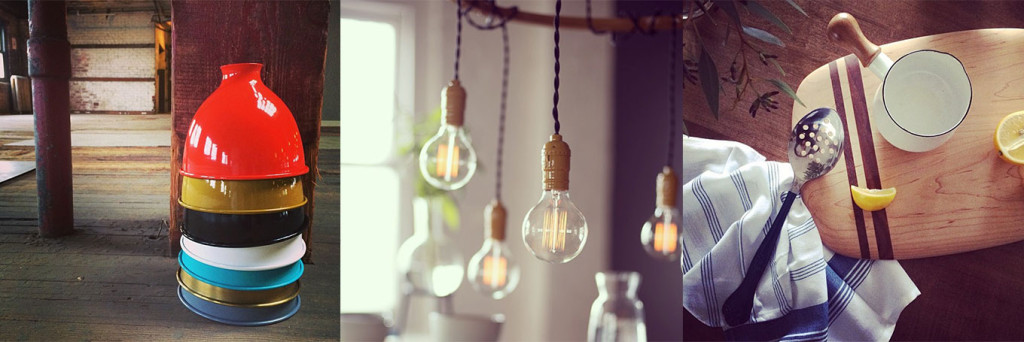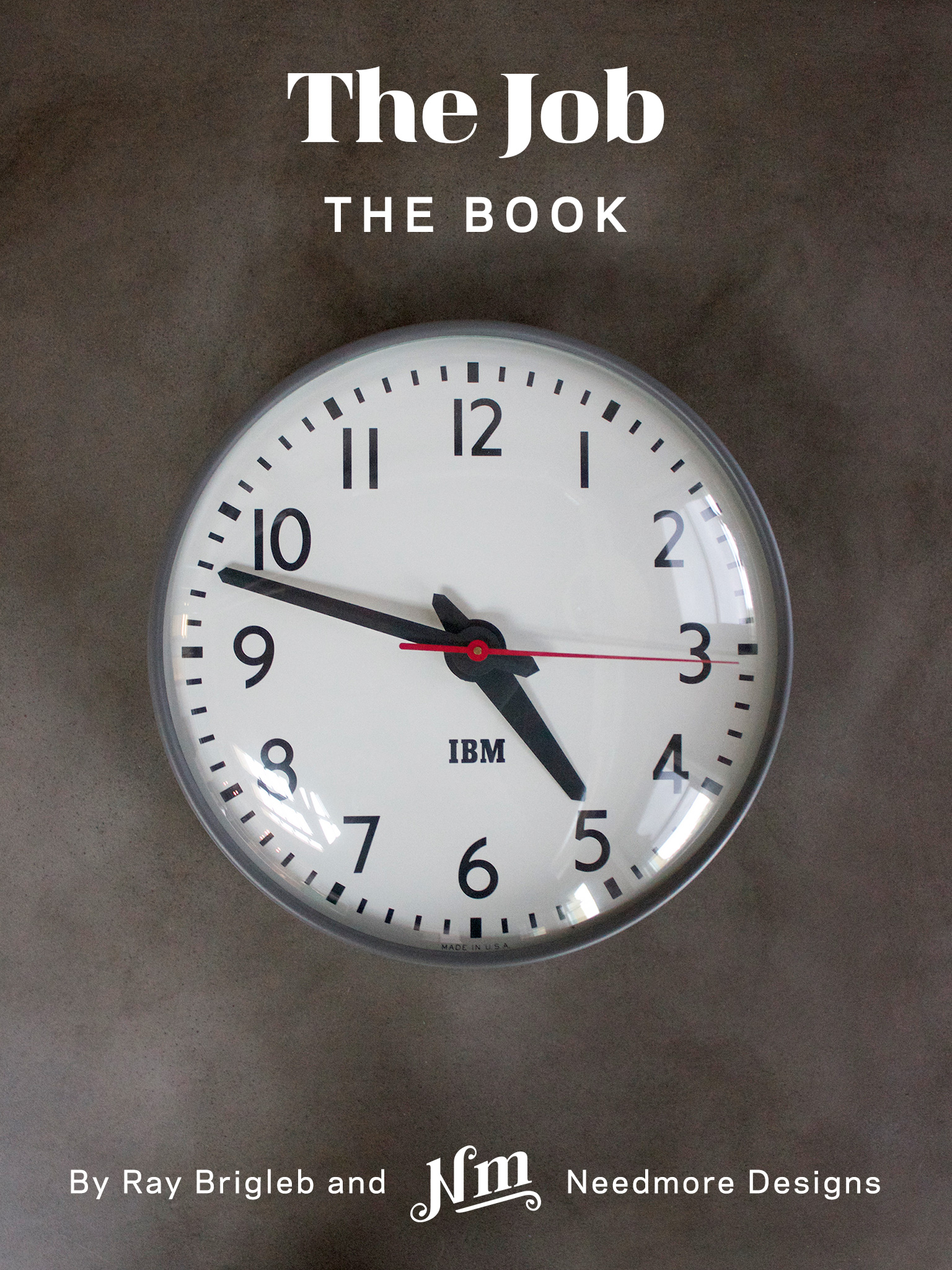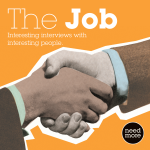
We’ve been fans of Schoolhouse Electric for years. Founder and owner Brian Faherty tells us about their story, their philosophy, and what’s up with that crazy “Fire Water” room of his.
Show Notes
The Interview
- Ray:
- Hello Brian.
- Brian:
- Hey, Ray.
- Thanks for coming down today, just to get water. It’s good to be here. Let’s just divert in, are you from Portland or are you?
- I am.
- Okay, okay.
- Slightly closer there by.
- Before Schoolhouse Electric you are a realtor, is that what you’ve done in your adult working life?
- Pretty much, yeah I think it was 15 years, 15 to 16 years in the Residential Real Estate Business over in the East side of Portland.
- Okay. The story, the origin myth if you will of Schoolhouse is you’re going to have to correct but, you found inspiration from that, and the vintage pieces that you would see to start that. Why don’t you tell the story better than me.
- Yeah, I was working the Residential Real Estate, on the East side. Typically they’re older, older homes. Turn of the century through mid-century homes. A lot of the Portland was developed in the 20’s before the Depression. I was becoming acutely aware of sort of what types of products people were using when they’re refurbishing houses. Because this was at the start of the kind of DIY movement, it’s a lot of … People are buying properties, and then restoring them or and then reselling them or keeping them or what have you.
As a part of that entire process, that’s what … Day in, and day out that’s what I did. I was able to see sort of what … How people were doing it well, and how people were doing it not so well and everything in between. What I started to notice was it seem like there was some opportunities and some of the sort of the finishing aspects of the restoration process, and whatever that I saw that was probably the most amberwood was lighting.
I felt like I wanted to … I kind of started to do research to find out what happened to a lot of the old fixtures that would have been initially been installed in these homes. The one that I was the most interested in were the ones that little utilitarian like what would have been in the kitchens or the bathrooms, or the hallways. There wasn’t so much the chandeliers, or the real highly decorative pieces, but it was the ones that I thought were the most useful.
Some of those fixtures were school house type fixtures, the old mill glass shades, and browse fixtures. The ones that were on the market place, were kind of ubiquitous you’d see the same one everywhere, and I thought it had … From watching a lot of old movies, and looking at old books and magazines, I just … Looking at hippo hardware and other stores I knew that there were a lot of other shapes and styles out there.
They had seem like they kind of vanished. I tried to figure out why was that, because it seems like those are the most suitable for those properties. Not only homes, but they are pretty flexible, they could go into boutique commercial locations, stores and coffee shops and cafes and things of that nature. I sort of like that boutique kind of market place. I found that there were after the war, the hand blown glass process had kind of gone away and they had moved more towards like a press glass process because it was easier.
Styles had changed, as styles had changed so are the process. There were some companies that had hang on to these old moles that the glass was blown into. One of them was in upstate New York, one of the only ones I would say that had a lot of this, these caches of old glass mold was in upstate New York. Went out there, and met with them, and look it up. They had interesting … They had warehouse, and kind of kept all these molds, even though they were …
They had really no interest in using them anymore. It was a same family that been in the business since the 1860s. They brought down the molds, and put them on the floor and pallets on this big warehouse and I started to kind of look at them, and inspect them and you couldn’t open a lot of them because they’re rusted shabby. Kind of feel me inside to see what the shapes were.
I knew when I found those molds, and when I had negotiated with the family, and start to purchasing them that I have something that was authentic and it was something that if I could have these mold restored, and have the glass blown back in them that it wasn’t, as if I was just like knocking off sort of fixtures from an era long gone. But that I would actually have, the glass would be blown in the original molds again turn of the century, through the mid-century.
I work from the glass backwards into the fixture to figure out how I could come with like a nice offering to people that were in that sort of process of fixing up their homes or their boutiques sort of cafes or coffee shop or things of that nature. I so started with that.
- Who are your first customers? How did you start out? Did you just … Was it word of mouth or did you run ads or?
- We place some ads in … I want to say it was like this old house, American bungalow, some small kind of shelter publications. The thing that probably ignited the most was the fact that I think that it was press worthy because it was an interesting story because I think that they wasn’t, there wasn’t really a lot of other companies doing the same thing out there? We also … We all started kind of the hand painted process again where we were painting the glass shades and things of that nature which is something that was done kind of during the depression, to kind of cheer people up.
Really it was kind of one customer at the time, we had a catalog the web wasn’t happening at that time, we had a store front on MLK, there were like three of us working there at the shop and I think it was something that I didn’t even going to payroll I think like the fourth year of the company being open. Because I knew everything had to kind of go back in, keeping the doors open.
- Was there like a … Were you still doing real estate during this time?
- I was, I’m still doing real estate.
- Was it kind of a transition it wasn’t just …
- Yeah, I have two jobs, I remember I bought this white Ford Ranger truck with a canopy. Because I had to kind of change my own, my personal style because I needed really attract the for around parts round and stuff. I drove home my wife looked at me, and she was like “Oh my God, I married the cable man.” That’s kind of what it took, and I meet my customers at the house I shown them as supposed to driving them my own car, I had a pickup, I had a two seat pickup trucks.
- I remember that MLK location, that worked out really well. I mean it was a nice show room, because the character of the building fit what you were showing and selling there I think.
- I did, it was a nice sort of Victorian type, Victorian Italian Eight building. It had real high ceiling, it was a nice space.
- My … I think when I had an epiphany about that sort of stuff, obviously the shop is a great place to see that stuff. We mention Venerable earlier and we work with them to make a website for the Washington High school building that they’re remodeling. They’re taking everything out. We did a tour of the building, to start of look around and I was just freaking out like they had those old IBM Clocks and like the great old light fixtures and stuff that haven’t been touched in many, many, many decades.
They have like intercoms with little things you pick up and talk, and I was just … How can we get this stuff, I still haven’t heard, I think they’re avoiding us about getting some of that old stuff. I know you saw some stuff like that too. How was it that you came about selling, what appears to be a vintage IBM clock from my childhood like that sort of thing.
- I think I have shared that with you, I love the old school clocks, just like institutional clocks or just indicator clocks and a lot of those were master and slave type systems. To take those out that school would render them sort of useless because there’s a whole system. Our graphic design firm that we’re working with on our sort of lifestyle launch when we went from a lighting company to a lifestyle brand VSA partners.
They’re out at Chicago and they work with IBM, it was their hundred year anniversary so I was able to kind of get up a meeting with IBM, getting the licensing agreement with them, to actually to have American made 1960’s IBM indicator clock, they’re really excited about it. We still have that agreement with them, and we’re still selling a lot of IBM clocks and … We’re in the process of working on GE on one as well right now.
It’s just kind of becoming this thing, it’s great.
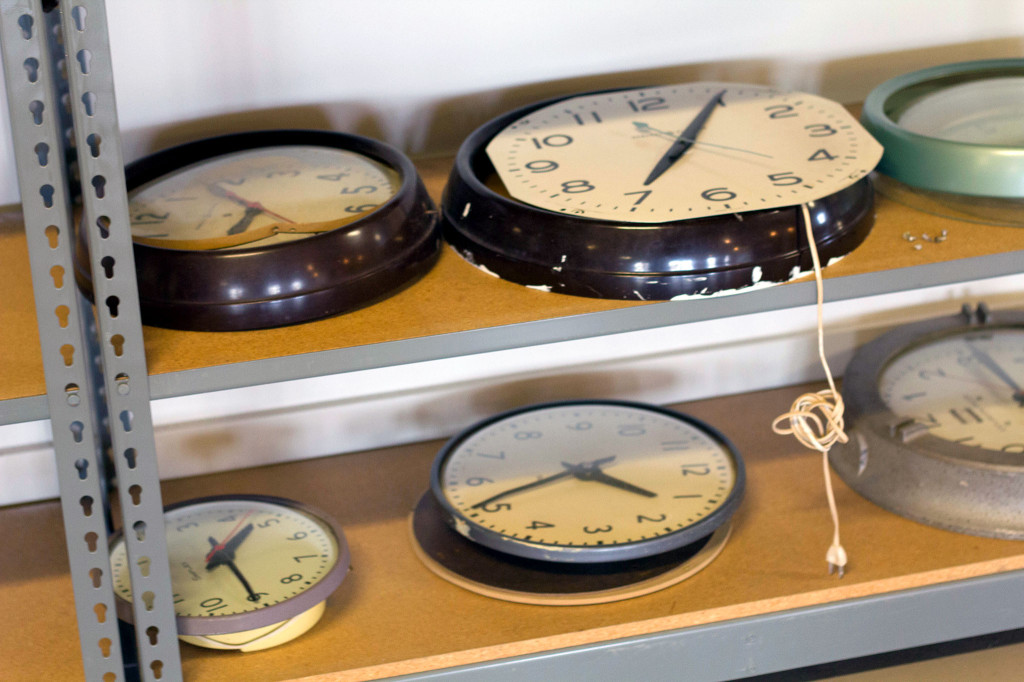
Clocks used as inspiration for a new Schoolhouse design.
- I’ve heard that you make most of your stuff in Portland is that still true?
- That’s right.
- Is it actually, in the by where the show room is now?
- Yeah, we do all of our finishing and assembly in the showroom there in Nicolai.
- Hand painting and everything.
- Yup.
- Does it make people happier the stripe? Do you still do the stripe?
- We still do stripes. We do a lot of hand painting on fixtures at the Nicolai building but the striping is done actually in West Virginia where our glass is blown.
It’s literally like a room full of grandmas that sort of have this little spinning wheel, and they’re just sitting there holding the paint brush to the glass and one by one … I think it does, I mean right now we have the stripes we have on our fixtures where really anything that you’d see back in the 1920s.
- There are sort of stripes are really in right now, blue stripes or gray stripes, or black stripes on some of our fixture. I think they do make people happy and we have just gone through this recession so I think that there’s … I think there’s something about patterns and stripes and plaids and things of that nature that are nice as supposedly just solid colors or just white.
- Do you … Does your inspiration purely come from finding old stuff or are you to the point where now you kind of just are starting to come up with completely unique original out of blue sky concepts and products.
- I mean, I think a lot of the … I think a lot of the products come from somewhere as supposedly just like … They’re born out of other ideas like fashion is a big inspiration to me and to the my co-creative director Sarah Culbertson that I work with at Schoolhouse in our team. You be surprise, that it is there that … It just comes out like come out from Nature, there’s a lot of different things that are inspiring to us.
The one thing that’s been sort of at the route of how we developed product though is this idea about usefulness. We don’t really necessarily like to develop things our products that are just really pretty that you just admire on a shelf or something other things that you think that people can … To make their daily lives more useful. Particularly in this, in the world that sort of have consumers that were in now where everything is so disposable how … We buy these things for our home or for our lives.
From big box stores or the Ikea that target all those things. Our family is guilty of as anybody. I mean I have three kids, and it’s we can only afford so many things that are American made or hand made. Yet, I guess our market place kind of lies in that area where people … They want to buy some of it that’s more lasting, that’s going to last longer that they’re going to appreciate more than those sort of disposable things.
I mean I kind of look at it like in my life, like I have this, if I have 2 circles and one of them is sort of reality, and one of them is fantasy, there’s an intersection between those two things. When I think how I live my life, when I think about my house, I don’t think about it like a museum or a place it’s just beautiful that people would walk in “Wow look at this.” I think about it more … There might be a little bit of that like aspirational thing.
A lot of it is because I have a family, and because we use every square inch of our house sort of … We are those two intersecting circles, we’re kind like look really cool but also be useful and functional, and not ostentatious but sort of practical, how can the things that are practical in the house also kind of make me smile. That could be like from utensils that helped me brush up the bark dust from when I build in the fire, to the log carrier to anything.
It can be sort of things that are kind of domestic utility items, or art, or anything. We also really, I have a strong belief in reusing things and so that’s another sort of chart at our company, we’re not so much like. When you look at restoration hardware, and you see their … Their showroom let’s say now it’s called gallery. To me it be difficult to look at that environment and think “How do I mix my own … How do I kind of take my own things and mix in with there. It’s like it’s almost like, it’s kind of a I don’t know.”
It’s like you have to kind of buy that entire look, and kind of to buy into that entire look. We’re saying is we think people should bring their own relics, and their own … The couch has been in the family a long time, or the chair or the arm wire or whatever it is and kind of mix it in with things. To me that’s more of … To me it’s a little more interesting to look at your life that way, to sort things from the past.
I don’t want … I’m not looking for anything to be brand new, or all shiny or just had purchase as it look. It’s kind of like things that we drag along with us, or that we get or we keep on our family for years and years. It’s kind of finding that balance I think is important. For us it’s more about like are there little things you can get from us, that are going to help you and your own, how to put together your own environment.
- I think for me, maybe nothing is more emblematic of that, than some of the light bulbs that. I mean because I have taken a pretty ordinary looking fixture. You put one of those light bulbs in there and suddenly that fixture just seems like a hundred year rich history, which frankly it probably does. It’s a very beaten up fixture. I think perhaps those products came along in just a right time where like every light bulb in my home probably a few years ago was fluorescent because of course that’s good for the earth and everything.
There’s definitely something missing and when you can bring back in something that’s an incandescent light … Is that the right word?
- With the email, with the elaborate filaments that you can look at, it’s like, I can’t believe someone actually makes this. I have furniture that’s real deal, but it’s crazy that I can, got them by a light bulb that actually works with that.
- Those light bulbs you’re going to be able to use for a long time because they’re basically called novelty bulbs now, with everything, the incandescent light bulbs are going to be going away and now the LED is sort of coming in to be I think the major sort of consumer bulb. I don’t think you’re going to see as much of the fluorescent type stuff. I think that’s going to kind of go away. It’s going to be an interesting transition, I’m glad that we’re still able to use the Edison bulbs and the Marconi bulbs, because they are, they’re sort of the, they’re atmospheric, they’re kind of like electric candles, if you will and that they really are nice.
- I mean provided one didn’t light their whole home with it, it’s a nice accent. I mean is it something where that’s actually been a challenge for your business that people are using so much fluorescent or LED lighting that kind of thing?
- I think since our lights aren’t necessarily, I mean we have, like some of the school house shades are really the white globes, I mean those are great task lighting. They distribute light very evenly but when you get into fixtures where it’s clear glass and you want to have an Edison, a Marconi bulb or something like that, I mean those are more. I think people are using those sort of more sporadically and there certain places in the room, it’s where maybe you’re not going to do homework under that light bulb, necessarily but it’s going to set the mood for a nice dinner party or for kind of visiting by the far. I think there’s as good as a balance between bulb.
- Do you … when you’re working on. Let’s say you’re developing a product or you’re working out on a new design, do you reach a point where you’re like this isn’t something we can sell, this isn’t … this is just a dead end. Is there a point in which you know like are you thinking about how something is going to be manufactured from day one, is that part of your thought process?
- Yeah. It really is and we’re … imagine sort of like a starting line with 12 toy cars at the beginning, not that cars are the product but they stand for a product. You’re kind of moving all those things ahead as far as you can in terms of who were the vendors we’re going to work with on this part, like what part of the process are we going to be involved with, are these parts we can even get, are we making enough of them to where it’s even going to be. We can find a marketplace for us.
That’s about the size of our company is, we’re not buying containers really full of anything. We’re not a cash and carry story there. A lot of these things we’re developing in-house or we’re either adding value to the process or we’re actually having parts made for a certain product and then finishing that thing in-house. Now there are a lot of other products that we just buy like bedding or something that we have made elsewhere.
It’s a lot of it is like can we make it, can we make it here, is it going to be competitive, is there a marketplace for it. Yet there are a lot of things that we do, that a lot of other retailers wouldn’t do, because they would say, well, this makes no sense because you’re only going to sell … you’re going to run out of capacity with the company you’re buying that from. They can only make 50 of those blankets a year.
If you’re only going to sell 50 blankets, why would you even do it? For us it’s like well, the only reason we do is because we love the blanket and those 50 people that get those are going to probably come back and see what else we have later so it’s … we’re sort of set up for the small batch manufacturers, which that’s what we are.
- With your … how long have you been in your current location in Portland where you’ve had retail in there?
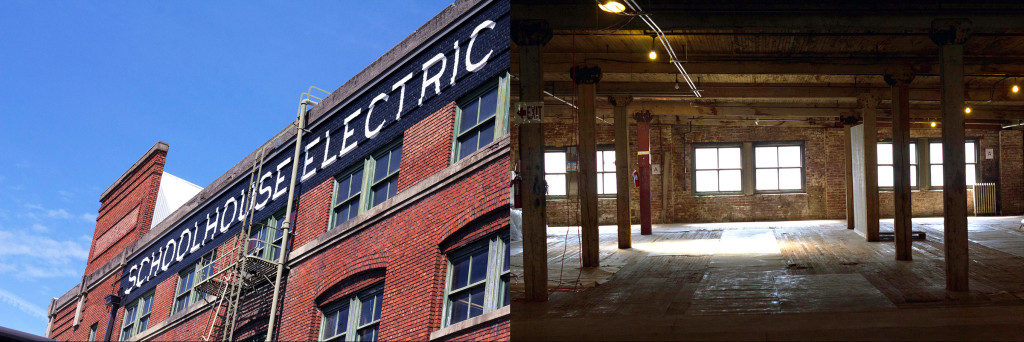
Schoolhouse Electric, views from the outside and the inside.
- We’ve had retail in there since 2012.
- Okay. Did the … were the flowers and the coffee, are those in there from day one?
- I think yeah, I think those … they came in like maybe 90 days after we opened.
- Okay, what was the inspiration for that?
- I mean we had this beautiful building that was kind of a little bit off the beaten path, sort of on the edge of Northwest Portland, it’s right at the start of the … what’s considered heavy industrial sort of zoning. We thought if we’re going to get people to come to our location we want there to be a certain experience for the customer and part of that, bringing in Rostrata Rosters who I’ve known for a long time and I really respect their craft and how they approach what they do.
The agreement was if they could help with the build out of that space and I would help with it as well, that I wouldn’t charge them rent for that space, same thing with Anna Mara Flowers. We have about a 7,500 square-foot space there and so I thought for Rostrata Roster has 300 square-feet, what am I really going to benefit from getting $20 a square-foot for 300 square-feet. Like $600 a month. It’s like what I want is happy customers, people that come in, who can hang out whether they’re shopping in the store or not.
I really want it to be sort of a destination and I really, to me, and to the company what’s really important is sort of the experience that our customers have and by having fresh flowers and coffee, I think it just makes it more of a special experience to come to the store and hang out there for a little bit, it’s more enjoyable I think.
- You have a shop in New York?
- We do.
- How is it been received?
- It’s been great. It’s been there for nine years.
- Okay. I have no idea. Wow. Okay. You don’t do any like manufacturing there? It’s just …
- No it’s just a store front.
- Okay.
- Yeah. We have, so recently when we went from lighting to lifestyle we had to really change that showroom out, because it really was more of a showroom before, now … right now it sort of feels more like a mercantile experience. It’s because we have no storage space, there’s no backroom. We’ve had to get as much stock into that space as we can. A lot of things are shipped from Portland direct to consumer but for those who like to walk in and buy something from the store, we have it set up where you can actually … there’s quite a bit of product actually you can buy in the store.
- Interesting. When I saw you at TEDx last year, which was a great talk. You talked about your fire and water room. Can you just give me, our listeners a brief explanation of what that is and how that came about for you?
- Well, when we’re building out the offices, the studios and the retail production facilities, the whole thing at that building, there was this little room off the dock that was the old shipping foreman’s office. Knowing just myself and kind of how I work in the studio environment. I really like to have like a place, I always really wanted a place that I could go where I wouldn’t be interrupted. I could have meetings with people where there’s not people walking up to me door and looking in and kind of like give me that signal like do you have a minute or whatever.
I really wanted a space where I could have more meaningful sort of connections and discussions with people. At the same time I really wanted to have a space that I didn’t use, my iPhone or my iPad or I didn’t have like any sort of hard line to my … the whole world of like the Internet and sort of smartphones and things of that nature because I really … I don’t know about you but my life is so consumed with that world and meetings and all that stuff that … I’d like to have a space where it’s like that’s off-limits. Where you just … that’s not what I do in that room.
I built myself this what I call sort of a fort, a place that I can go, I have a wood stove in there, I have sparkling water and, a few chairs, I have an old AM/FM radio and I have a lot of meetings in that room. Some of them are work related and some of them aren’t but it’s nice to kind of be in that building but they have to space where I can get away from things and nobody comes and knocks on that door. There’s a rule that you can’t come and find me in that space.
It’s nice because it sort of enables me, I think to be more present when I am in a meetings in other parts of the building but just by having that space where it’s like.
- I wonder if you have that space now?
- I have that space for almost two years now.
- Okay.
- It was done at the same time that we were building out the store.
- Okay. Do you feel like it’s changed you, your personality, your mood at work to have it out there?
- I think it has. It’s like we’re in the process of designing and building a beach house. We had a beach house before. I’ve always had a place to get away to. For me, it’s not always even that I go to that place but knowing that I can go to that place also just sort of kind of helps me with my bandwidth issues. That’s kind of my problem is I really … as this company is growing, we have more employees and there’s more happening and there’s more demands that me … I find that my … I have to really careful with how I fill up my bandwidth because it’s I’m only as effective as sort of my own resources.
By having that room, I feel like it gives me a little flexibility with my bandwidth, with people, with process, with systems, with all those things that I’m forced to work on, that maybe you don’t want to spend as much time on. The thing that I enjoyed in the most is working on developing product, like marketing sort of ideas and think about the customers, that’s sort of. Those are the areas that I like to spend most of the time in.
With the growing company, there’s personnel, there’s all that … the finance, the systems, the processes, all these other needs and I don’t know. It helps me with the balance of my life, I guess but it has changed me in some ways, yes.
- Is it a completely serendipitous or just a random thing that you would go in there or is it like do you find yourself tending to go in there in the afternoons or certain time of day where you just sort of retreat into your fort?
- Yeah, I mean it really depends. It’s … depends on what kind of meetings I have because during the winter time I have to have a fire in that room otherwise it’s too cold to even be in there.
- Right.
- I have to give some thought to it. If I know I’m going to have a couple meetings in that room, I have to go in the morning and get the fire going.
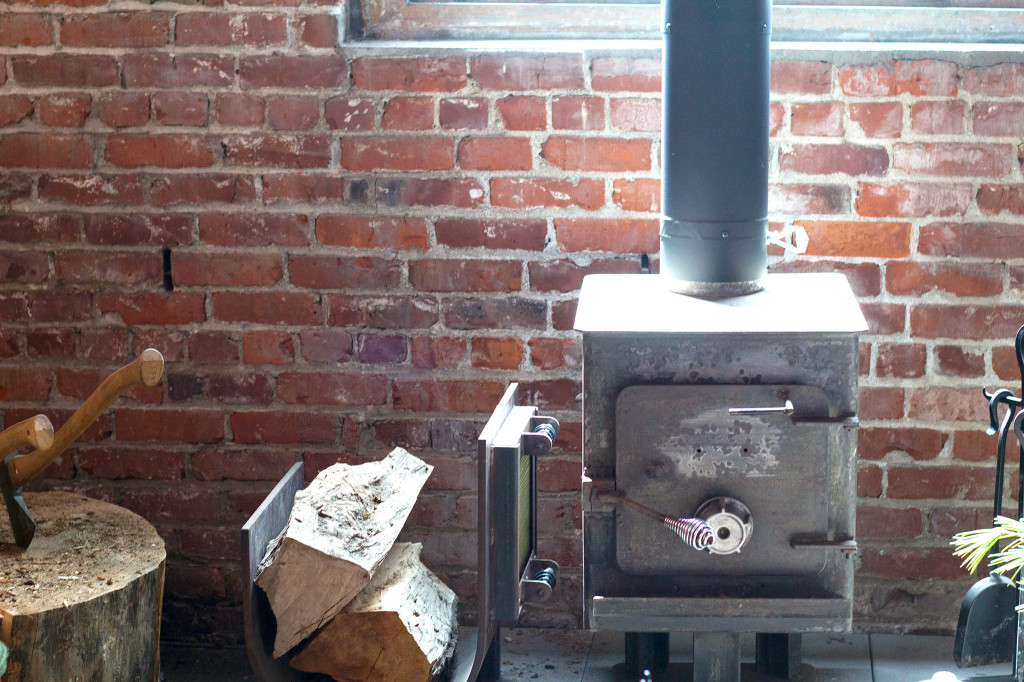
The fireplace in Brian’s studio.
- Okay.
- I also like that kind of preparation as well.
- Right, that’s interesting. That’s really interesting. It kind of … I was wondering I read a little bit of … a little bit about that room preparation for this conversation and I heard more than once about you listening to KMHD, specifically, is that that the radio won’t tune to other stations or that there’s no other suitable station in Portland for that room? Or are you actually a jazz fan?
- I’m not like a … I don’t have a ton of like … I have a record player in my regular office and I do have some jazz albums. I wouldn’t say I ever been like a huge jazz fan, there’s something about … and this is an old like 1970s, it’s actually an 8-track player that happens to have an AM/FM radio with it, but there’s something about the sound that comes out of that with that jazz.
The thing I love about KMHD is I don’t think I’ve ever heard the same song twice. It’s different forms of jazz and …
- Yeah.
- … it’s like I just … I don’t know, it’s almost like I don’t know, I feel like there’s something that’s unfamiliar about it that I love. Even though it’s becoming this familiar. I’ve had it on KGON in there a couple times. It’s just … it was okay but it just doesn’t seem like, like having like Led Zeppelin or something. It’s just wasn’t that relaxing, it’s … I like that it’s kind of a … I know sometimes I have … I’ll be meeting with someone in that room and I’ll have it on KMHD.
I kind of sense that it may be is a little bit too loud for the person that I’m meeting with and I’ll maybe turn it down a little bit for myself, I almost liked to have like those two things going at the same. It does something to me … it’s like when I run, I like listening to music. Then I can think and have the music at the same time. I felt like I can do both those things so it’s … I don’t know, it’s maybe the same thing in that room. It’s relaxing.
- This is probably unrelated but well, it is, because this isn’t all about me. We … my wife and I often go to this, it’s a lighthouse that’s also a bed in breakfast kind of between New Hance and Florence on the coast and all the rooms have these old, old, old radios, the sort of almost pyramid shape around it, there’s probably a name for that shape. They look like little cathedrals. They’re wonderful but of course you can’t really get radio there. There’s really nothing to listen to.
For the longest time I had this little adapter for my iPod, that so I could get Internet there, strangely enough, I could get my iTunes radio to play through there where I would have like old jazz and then it would transmit that through a little FM transmitter to the radio and then just hide it in the drawer, because I like being in this old, old room or old … everything was so vintage around me, I just like the fact that that radio could actually play period music.
I like to imagine that like the light-keepers, although I’m sure they didn’t get radio either but they would be listening to that, it wasn’t a question, that was just me ranting about.
- I think that’s … it’s actually, you said it, because we’re in this world where it’s like everything is at our fingertips, I mean we can see who Jimmy Fallon was singing or dancing with last night, you know what I mean, the history of rap or whatever. Anything we want it’s right there, yet the thing that sometimes sounds like you desire and I do too, is just sort of that that thing that’s always kind of going, that we don’t really pick, it’s just like, they’re serving you something else.
I don’t know, I get fed by that as much … I think a lot more than just me sort of tapping into sort of the Pandora of the world, like, I don’t know. There’s something that’s … maybe it’s because that’s what they used to have and it’s … things are so selective now, I don’t know. It’s with this on demand world that we live in. It’s nice to take a break from that. I think.
- Where did the name fire and water come from? Random question.
- It was, like the kind of the basic elements. Because I have the wood stove and I have this old GE refrigerator full of sparkling water. I just … it’s like, really there wasn’t a ton of thought into, I made this little logo, this FW logo that I like. People like, what does that mean?
- Do you prefer a pen or a pencil?
- Pencil.
- Okay. Mechanical or …
- No, just an old like, just the number 2 school, yellow.
- Okay. Have you seen this book?
- No. I haven’t …
- This is my gift to you.
- Thank you. I never have.
- You’ll love it.
- How to sharpen pencils.
- Absolutely love that book.
- Funny thing is is I do collect pencil sharpeners.
- That does not surprise me, in the least but yeah, that’s funny.
- That’s great. Thank you very much.
- Well, Brian, thank you so much for talking to me today. Appreciate it.
- You’re welcome. Pleasure talking to you.
- Cool.
